- Author Matthew Elmers [email protected].
- Public 2023-12-16 21:49.
- Last modified 2025-01-24 09:17.
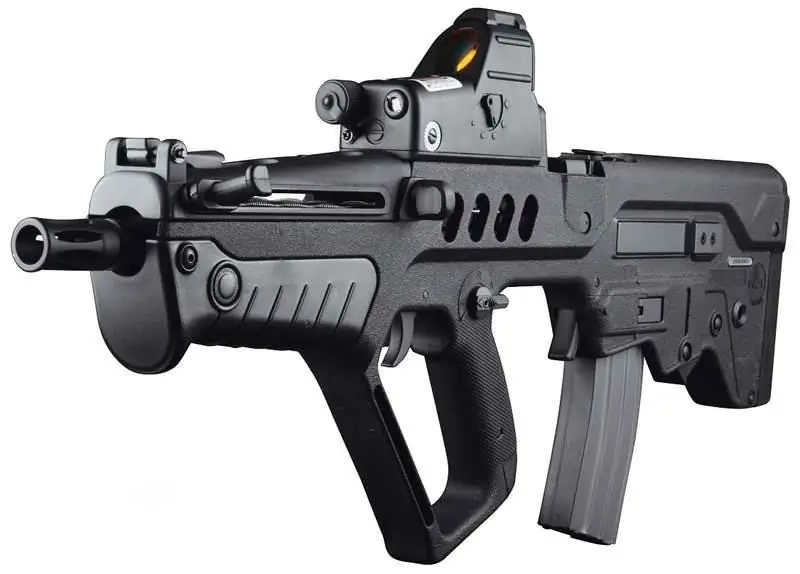
In the early 90s of the last century, the Israeli army needed new automatic small arms. The Galil machine gun was still of some interest, but it was already outdated, which is why a competition for a new weapon was announced. Shortly before the announcement of the purchase of new weapons by IMI (Israel Military Industries), which was still state-owned at that time, work on a new machine gun was initiated on an initiative basis. Nevertheless, the creation of weapons is not a quick matter and the leadership of the IDF decided to finance the IMI project, and before launching it into series, purchase a number of American M16 rifles. Indeed, the machine went into production more than 10 years after the start of work on it. During this time, IMI managed to become a private company and renamed itself IWI (Israeli Weapons Industries Ltd).
Feeling the current trends in the arms business, IMI initially developed not one sample of weapons, but a whole complex based on one mechanics and the most unified parts. The prototype of the line was shown to the public in the mid-90s under the name M-203. However, soon, so that the machine gun would not be confused with an under-barrel grenade launcher, it was renamed AAR - Advanced Assault Riffle (progressive assault rifle). In 1998, the assault rifle finally received a name that did not change anymore: TAR-21, which stands for Tavor Assault Riffle 21 century - the Tavor assault rifle of the XXI century. The machine was named after the legendary mountain, called Tabor in Russian transcription.
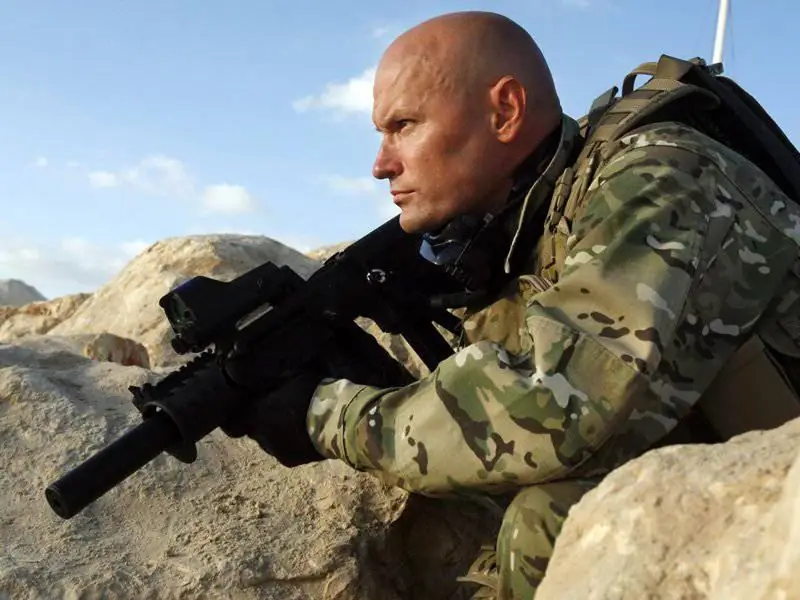
The main feature of the TAR complex is the bullpup layout. The weapon's automation works by removing the powder gases, the gas outlet is located in the weapon body above the barrel. The gas piston is rigidly connected to the bolt carrier and therefore has a long stroke. The barrel is locked in all versions of the machine by turning the bolt (seven lugs). The details for the extraction of the sleeves are located on the shutter. Interestingly, IMI engineers have provided for the possibility of a small alteration of the shutter, so that the sleeves can be ejected through a special window on the left side of the receiver (by default, the sleeves fly out on the right). Left-handed shooters will be grateful. A similar situation with the loading handle - there are cutouts for it on both sides of the plastic case; it is not rigidly connected with the bolt group and is motionless when firing. The Tavor's trigger mechanism does not have any revolutionary innovations. It is made according to the trigger system and is located, like other automatic machines of the bullpup scheme, in the butt. USM has two modes of fire - single and automatic. Switching occurs using a flag located above the pistol grip, again, on both sides. A three-position translator (safety, single and automatic) is connected to the trigger with a rigid pull, like the trigger. Most types of weapons in the Tavor range use 5, 56x45 NATO cartridges, but this is not the only option (more on this later). The stores also comply with the standards of the North Atlantic Alliance. The standard Tavor box magazine holds 30 rounds. The rate of fire of the basic machine is within 750-900 rounds per minute.
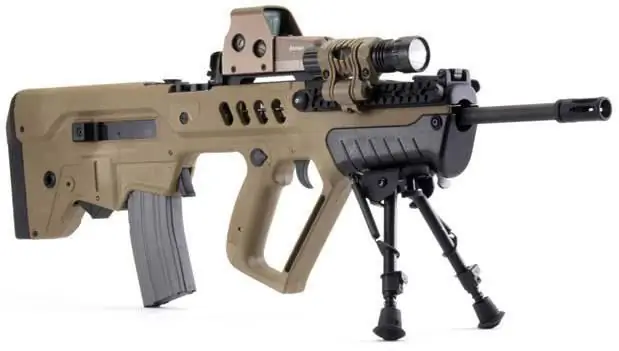
Assault rifle Tavor TAR-21
Most of the body of the machine, with the exception of a few light-alloy and steel parts, is made of impact-resistant plastic. The trigger guard of the basic TAR-21 is large and completely covers the shooter's fingers. Due to the layout of the bullpup, a "carry handle" was installed for the convenience of aiming the assault rifle. Quotation marks are used here because the slot between the handle and the body of the machine is small enough to fit your fingers. The designers have provided for the possibility of incomplete disassembly of weapons in the field and without the use of tools. To do this, push the pin located at the top of the receiver in front of the butt plate (you can use a cartridge for this), fold the butt plate down and back and remove the bolt carrier. After that, you can do the rest of the operations for disassembling the weapon.
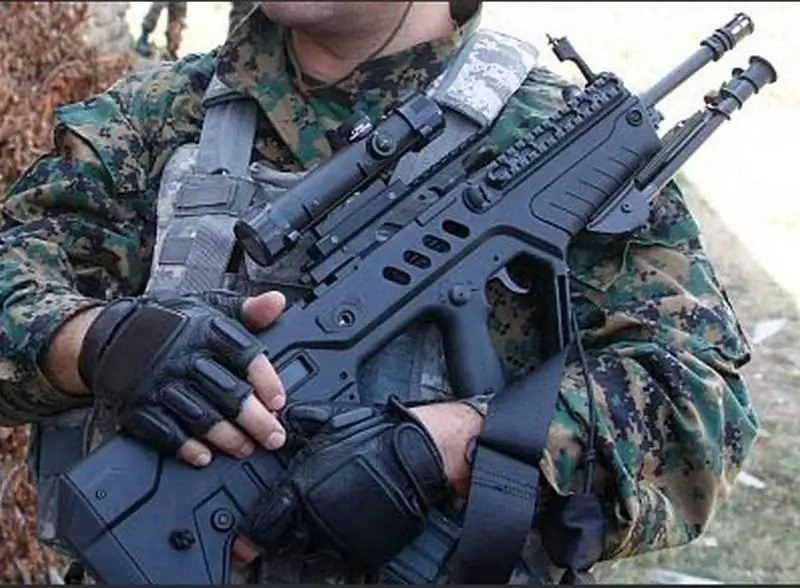
Early versions of the TAR-21 had no sights at all. Later, on production samples, there were open folding front sight and rear sight. Later serial TAR-21s are equipped with an ITL MARS collimator sight with a built-in laser designator. For operations at night, an appropriate night vision device can be installed behind the scope. Of particular interest is the "integration" of a collimator sight with an assault rifle: when the weapon is cocked, the sight illumination is automatically turned on, it also turns off on its own when the assault rifle is discharged.
Now the following modifications of the Tavor are in production:
- TAR-21. Basic model chambered for 5, 56x45 mm NATO.
- GTAR-21. Grenade-TAR is a basic model with a unit for attaching an M203 under-barrel grenade launcher.
- CTAR-21. Commando-TAR is a lightweight and shorter version. It has a barrel length of 380 mm versus 460 for the base model and a total length of 640 mm (720 mm for the TAR-21). Weight reduced from 3, 27 kg to 3, 18. The rest is similar to the prototype model.
- MTAR-21. The Micro-TAR is a sub-compact machine gun with a 33 cm barrel, a total length of 59 cm and a dry weight of only 2.9 kg. Also, to reduce the size of the large trigger guard in the entire pistol grip was replaced with a small traditional one. MTAR-21 was made as a personal self-defense weapon (PDW) for crews of armored vehicles, gun crews, etc. Also for the MTAR-21 there is a special kit called Convertion Kit to 5.56 / 9x19 mm, consisting of a barrel, bolt carrier and magazine receiver. After installing the kit on the machine gun, it can use 9x19 mm Parabellum cartridges for firing, which makes a real submachine gun out of a compact assault rifle.
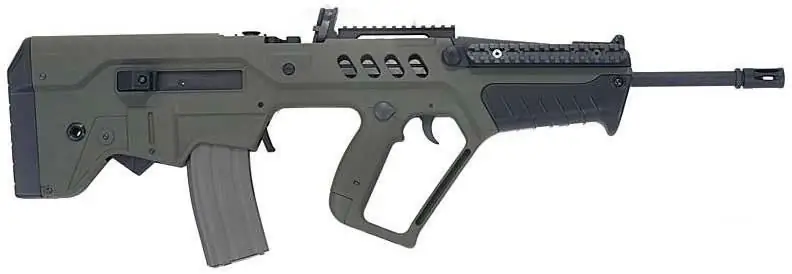

- STAR-21. Sniper-TAR is a sniper rifle. Supplied with a telescopic sight and bipod. The rest is similar to the basic automaton.
- TC-21. The Tavor Carabine is the civilian version of the TAR. It does not have the ability to fire in bursts, it is equipped with a magazine for 10 rounds and is equipped with a kind of "cushion" under the cheek on the upper side of the receiver.
Since 2000, various versions of the TAR in limited quantities have entered service with various units of the Israeli army, primarily the special forces. At that time, exercises were held in one of the IDF infantry schools, during which two platoons, one of which was armed with Tavors, and the other M16, stormed a building with a simulated enemy under the same conditions and fought a city battle. According to the results of the exercises, the TAR was recognized as a more accurate and convenient weapon in operation. The only negative noted by the Israeli military is the price. The basic TAR costs over a thousand US dollars. American M16s, in turn, are supplied to Israel on preferential terms, which is why they cost several times less than TAR.
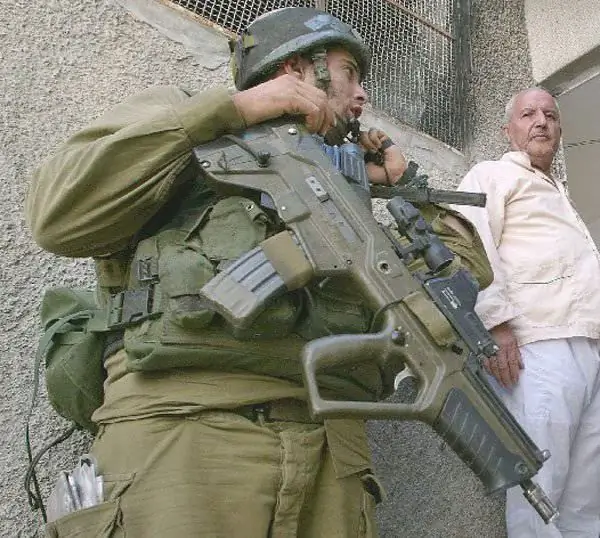
The economic side did not bother the leadership of the Israeli army, and on March 31, 2004, the Tavor complex was put into service. Until 2008, in order to replace obsolete types, the troops received 16 thousand of these machines. Foreign countries are also interested in Tavor, and not only in terms of purchases. For example, the Brazilian company Taurus bought a license to manufacture TAR. Since 2002, Tavors have been supplied to India, and these machines are also purchased by Guatemala, Portugal, Colombia, Azerbaijan and Ukraine. In the latter case, the final assembly of machines from Israeli components is carried out on the territory of Ukraine. However, there is still no information regarding the mass purchases of Tavor vehicles by the Ukrainian security forces. There is also a certain number of TAR-21s in Georgia, where they got in 2006 as military aid. It is worth noting that only in Israel Tavor are used as small arms for a simple soldier - in the armies of other countries they are available in extremely limited quantities, and then, mainly in special forces.






